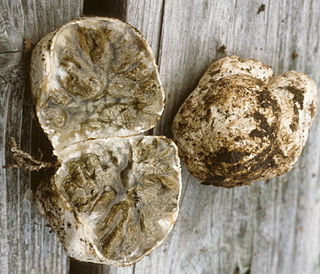
Streptomyces is the largest genus of Actinomycetota, and the type genus of the family Streptomycetaceae. Over 700 species of Streptomyces bacteria have been described. As with the other Actinomycetota, streptomycetes are gram-positive, and have very large genomes with high GC content. Found predominantly in soil and decaying vegetation, most streptomycetes produce spores, and are noted for their distinct "earthy" odor that results from production of a volatile metabolite, geosmin. Different strains of the same species may colonize very diverse environments.

Glufosinate is a naturally occurring broad-spectrum herbicide produced by several species of Streptomyces soil bacteria. Glufosinate is a non-selective, contact herbicide, with some systemic action. Plants may also metabolize bialaphos and phosalacine, other naturally occurring herbicides, directly into glufosinate. The compound irreversibly inhibits glutamine synthetase, an enzyme necessary for the production of glutamine and for ammonia detoxification, giving it antibacterial, antifungal and herbicidal properties. Application of glufosinate to plants leads to reduced glutamine and elevated ammonia levels in tissues, halting photosynthesis and resulting in plant death.

Streptomycetaceae is a family of the class Actinomycetota, making up the monotypic order Streptomycetales. It includes the important genus Streptomyces. This was the original source of many antibiotics, namely streptomycin, the first antibiotic against tuberculosis.

Streptomyces griseus is a species of bacteria in the genus Streptomyces commonly found in soil. A few strains have been also reported from deep-sea sediments. It is a Gram-positive bacterium with high GC content. Along with most other streptomycetes, S. griseus strains are well known producers of antibiotics and other such commercially significant secondary metabolites. These strains are known to be producers of 32 different structural types of bioactive compounds. Streptomycin, the first antibiotic ever reported from a bacterium, comes from strains of S. griseus. Recently, the whole genome sequence of one of its strains had been completed.

Protubera is a genus of fungi in the family Phallogastraceae. The genus has a widespread distribution in tropical and subtropical areas, and contains 13 species.
Streptomyces abikoensis is a bacterium species from the genus Streptomyces which produces the antibiotic abikoviromycin. Streptomyces abikoensis has been isolated from Abiko in Japan.

Streptomyces castelarensis is a bacterium species from the genus of Streptomyces which has been isolated from dust in Castelar in Argentina. Streptomyces castelarensis produces camphomycin.
Streptomyces cinnamoneus is a bacterium species from the genus of Streptomyces which has been isolated from soil in Japan. Streptomyces cinnamoneus produces duramycin A, duramycin B, duramycin C, carbomycin, cinnomycin and fungichromin.
Streptomyces filamentosus is a bacterium species from the genus of Streptomyces which has been isolated from soil. Streptomyces filamentosus produces caryomycin. Streptomyces filamentosus also produces the novel cyclic lipopeptide antibiotic daptomycin.
Streptomyces flavovirens is a bacterium species from the genus of Streptomyces which has been isolated from soil. Streptomyces flavovirens produces the actinomycin complex and mureidomycin. A strain of this species has been used to produce pravastatin.
Streptomyces griseocarneus is a bacterium species from the genus of Streptomyces which has been isolated from soil. Streptomyces griseocarneus produces hydroxystreptomycin, alboverticillin, sphingomyelinase C and rotaventin.
Streptomyces hiroshimensis is a bacterium species from the genus of Streptomyces which has been isolated from soil. Streptomyces hiroshimensis produces the red pigment prodigiosin.
Streptomyces lilacinus is a bacterium species from the genus of Streptomyces which has been from soil.
Streptomyces microflavus is a bacterium species from the genus of Streptomyces which has been isolated from soil. Streptomyces microflavus produces nemadectin, fattiviracin A1, milbemycin and deoxyuridines. Streptomyces microflavus also produces the ionophore valinomycin. Streptomyces microflavus is also known to cause potato common scab disease in Korea.
Streptomyces minutiscleroticus is a bacterium species from the genus of Streptomyces. Streptomyces minutiscleroticus produces the antibiotic aburamycin.

Streptomyces netropsis is a bacterium species from the genus of Streptomyces. Streptomyces netropsis produces the antibiotics netropsin and distamycin A and the antifungal polyene mycoheptin.
Streptomyces pilosus is a bacterium species from the genus of Streptomyces which has been isolated from soil in Rome in Italy. Streptomyces pilosus produces piloquinone and the antidote desferrioxamine B.
Streptomyces purpureus is a bacterium species from the genus of Streptomyces which has been isolated from soil. Streptomyces purpureus produces chloramphenicol, bottromycin and fradicin.
Streptomyces rochei is a bacterium species from the genus of Streptomyces which has been isolated from soil in Russia. Streptomyces rochei produces borrelidin, butyrolactol A, butyrolactol B, uricase and streptothricin. Streptomyces rochei has antifungal activity against Fusarium oxysporum f.sp. lycopersici and Aspergillus fumigatus. Streptomyces rochei produces moenomycin and bambermycin. Streptomyces rochei produces amicetin A, amicetin B, amicetin C and streptolin. Streptomyces rochei produces endo-β-N-acetylglucosaminidase mithramycin, amicetin, bamicetin, and plicacetin.
Streptomyces violaceoruber is a bacterium species from the genus of Streptomyces. Streptomyces violaceoruber produces protoactinorhodin, kendomycin, phospholipase A2, granaticin and methylenomycin A.





